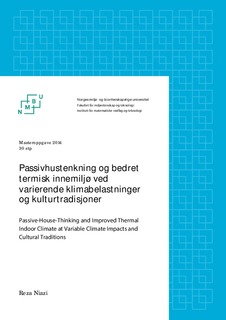| dc.description.abstract | There are two criteria that have been important to me when I was going to write this task. The first is to clarify how well masonry buildings in Herat are protected against external climate impacts and how thermal indoor climate is affected by the properties of the building's elements. In order to determine how well a building is protected against external climate impacts, we can look at the energy demand for heating and cooling through a whole year. This energy demand depends on the heat loss and heat gains. Amount of heat buildings lose, dependents on the temperature difference between inside and outside and the R-value of the constructions elements. Amount of heat building gains depends on these factors, but in addition, it is also dependent on solar radiation rate. Temperature difference between inside and outside is bigger during the coldest days of the winter and that is why being warm in winter is more important than being cold in the summer. When we dimension a building, is the highest temperature difference that we use.
Thermal indoor climate includes physical factors which has influence on our thermal comfort. These factors are air temperature, surface temperature, air velocity and air humidity. The first two factors dependent on how building`s climate-screen are build and how well it isolates against external climate impacts, while the other two dependents on the ventilation system and the activity inside. If one of these factors is on not at an acceptable level, we can feel uncomfortable and dissatisfied with the indoor climate.
When we build a passive-house, it is the amount of energy the house needs and what is the source of energy which is the parent criteria. When it comes to the first criterion, there are no specific regulations in Afghanistan, but if we manage to insulate the building to a level that both energy consumption and indoor climate are at acceptable levels, we have perhaps found a limit for energy consumption of an energy efficient building. This limit can be further processed and used to define the requirements for the energy-use of a passive-house in Afghanistan. The first criterion also dependents on the temperature difference between outside and inside. This temperature difference is larger in Norway during winter, while it is greater in Afghanistan during the summer.
Second criterion is about set claim to a maximum of amount of delivered electric and fossil energy. This means that we should be less dependent of fossil energy and encourage us to use more renewable energy like solar energy. The amount of solar energy depends on the degree of latitude and average sunshine time per day for a place. Oslo has the degree of latitude 59, 91 ° N, while Herat has latitude of 34, 20 ° N. This means that the solar radiation in Oslo has less energy per area than solar radiation in Herat.
Oslo has, on average, less sunshine hour per day than Heart because of air humidity and the high precipitation rate. If we are to build two buildings with equal area, one in Oslo and one in Herat, what is the different in the total net energy demands of those two buildings? | nb_NO |

